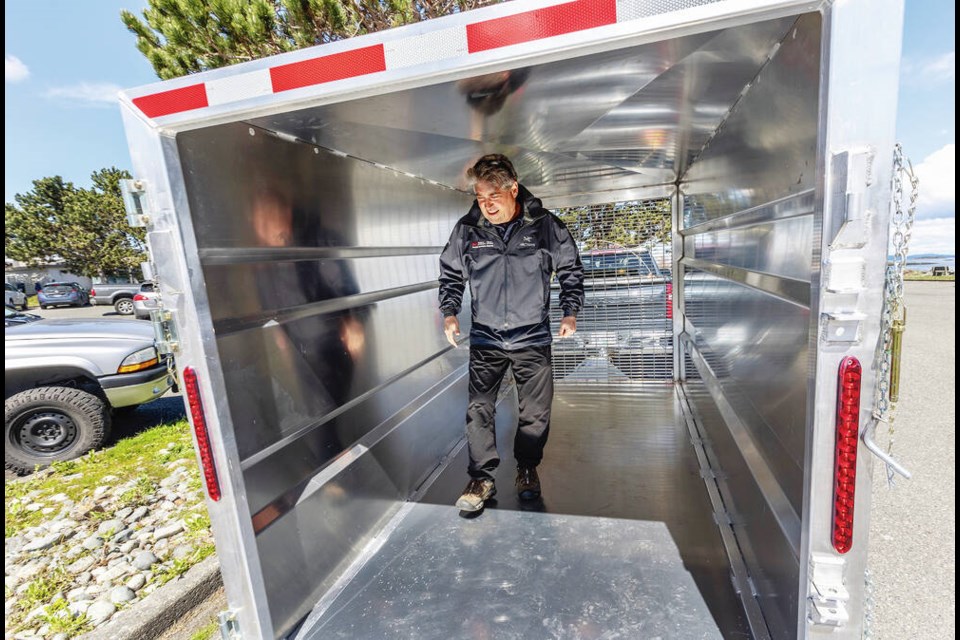It’s been dubbed Emerson’s Chariot and it awaits the wayward elephant seal if he decides to go wandering across the road again in South Oak Bay.
Fisheries and Oceans Canada delivered a shiny new trailer to Oak Bay Marina Tuesday afternoon. It’s heavy-duty aluminum, double-welded and brought down from Parksville, where it was designed with Emerson in mind.
The two-year-old elephant seal, who seems to love moulting in very public places around the capital region, crossed Beach Drive over the weekend to lounge on an apartment lawn — and stop, smell and squish some tulips.
Oak Bay police shut the road down for hours until Emerson could be herded by his back flippers back into the water.
Now federal marine scientist Paul Cottrell — fresh from the orca rescue in Zeballos — is on watch to relocate the 500-pound animal if he goes wandering into traffic again.
The new trailer is an improvement on the culvert-style bear traps DFO has used to move Emerson and other pinnipeds in the past.
“He’s a tough guy to figure out … he’s still young and is dealing with moulting and that takes some time,” says Cottrell, head of the DFO’s Marine Mammal Unit.
Elephant seals go through a catastrophic moult every spring, shedding their hair and skin in a painful process that lasts up to a month.
Cottrell said Emerson is about halfway through the process, with evidence of loose or shed skin around his face and head and tail flippers.
If he is moved, it will be the third time since last fall that DFO has had to intervene and move Emerson, who has little fear of humans and, in fact, prefers to hang out in urban areas even when not moulting.
Last September, Emerson hauled out on the Songhees Walkway in front of a senior on a mobility scooter, said Cottrell.
He was loaded in a bear trap and taken to Nootka Sound, only to return April 1 in the Gorge Waterway, where he spent time on the grass and then ventured into the bike lane and the road.
DFO rounded him up again and took him to Barkley Sound near Ucluelet. But six days later, Emerson was back, first on Gonzales Beach, then McNeill Bay and Kitty Islet before last week moving to Oak Bay Marina, where he did his first moult a year ago.
“How he navigates back here all the time, nobody knows,” said Cottrell. “But he sure seems to like it here.”
The new trailer was designed to easily load and safely relocate big guys like Emerson to far and remote locations, said Cottrell. It has an open cage front for good airflow, a low ramp and plenty of room inside.
The danger, said Cottrell, is having Emerson on the roads, where a collision could be fatal for the animal and humans. “They are hard to see,” he said, noting a harbour seal was struck by a car on Highway 99 two years ago. “That seal was 200 pounds, Emerson here is about 500.”
Born in January 2022, the elephant seal has gained an adoring following, with hundreds coming out to view him as he sleeps and occasionally rolls and grunts.
He’s certainly curious, peeping over the seawall when a car horn goes off or a dog barks. On Tuesday morning, onlookers watched him take a swim in the marina, playing with a loose float.
On utility poles along Beach Drive, posters have emerged showing Emerson in a top hat and proclaiming “Emerson for Mayor — The Seal Deal. Fish for all and Roads: Now nap zones!”
T-shirts with Emerson themes are also being seen around town.
Cottrell said more moulting elephant seals are being reported around the island, including at Weir’s Beach in Metchosin and two at Race Rocks.
Elephant seals got their name because adult males have large noses that resemble an elephant’s trunk. Males begin developing this enlarged nose, or proboscis, at sexual maturity, which is at about three to five years old.
Adult males may grow to over 13 feet in length and weigh up to 4,500 pounds. The females are much smaller at 10 feet in length and 1,300 pounds.
Cottrell said elephant seals are deep divers, going under water for long periods, where they hunt for dog fish and other deep-living marine life.
They were hunted for their blubber — which was rendered to oil for lamps — to near-extinction by the late 1800s. The last colonies were protected in Mexico in 1922 and the population has since rebounded, expanding their northern ranges to the coast of B.C.
Recent data puts their numbers at about 160,000.
Race Rocks, the ecological reserve in the Juan de Fuca Strait, is considered the northernmost birthing colony on the Pacific Coast, with up to five births each year. On Christmas Day 2022, two pups were born,





